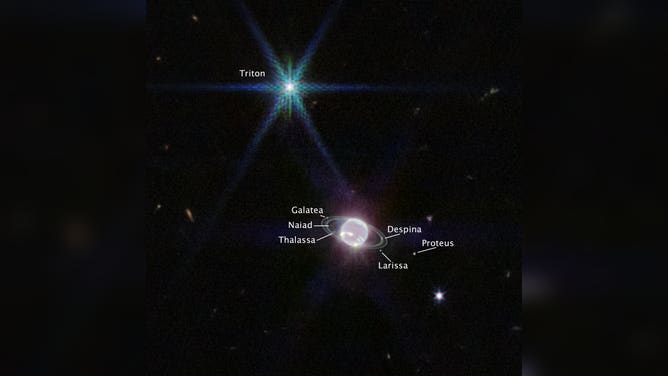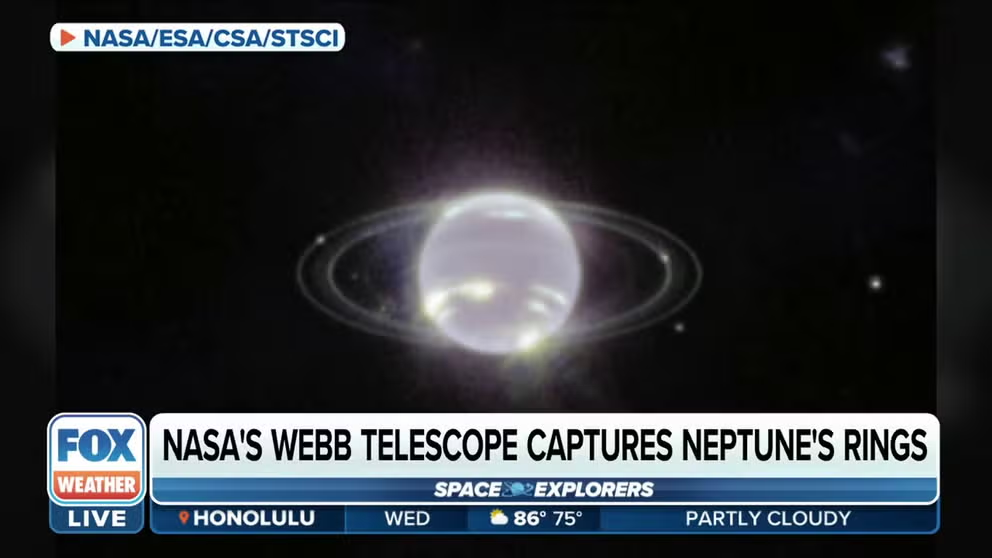Lonely Neptune's rings shine bright in James Webb Space Telescope images
Neptune's last visitor was NASA's Voyager 2 spacecraft in 1989. The James Webb Space Telescope just provided Neptune's first new headshots in decades.
NASA Webb telescope captures photos of Neptune
NASA's Webb telescope was able to photograph Neptune and its rings capturing the clearest photo of the planet in over 30 years.
Neptune, a cold, unexplored world farthest from the sun, is getting its time in the light after the James Webb Space Telescope captured new images of the planet for the first time in decades.
Last visited by NASA's Voyager 2 spacecraft in 1989, it was time for Neptune to get some new headshots.
On Wednesday, at the International Astronautical Congress in Paris, the European Space Agency released half a dozen processed images of Neptune and its moons taken by the powerful telescope in July.
While Neptune's methane gas makes the planet appear blue in Hubble Space Telescope and Voyager 2 images, the James Webb Space Telescope uses infrared light that can't be seen by the human eye.
JAMES WEBB SPACE TELESCOPE IMAGES WOW BY SHOWING STAR NURSERY, GALAXIES IN A COSMIC DANCE
To Webb, Neptune does not appear blue, but the ordinarily dark planet glows bright, and its high-altitude methane ice clouds are visible. The brightness toward the planet's equator "could be a visual signature of global atmospheric circulation that powers Neptune’s winds and storms," according to the ESA.

Webb’s Near-Infrared Camera (NIRCam) image of Neptune, taken on 12 July 2022, brings the planet’s rings into full focus for the first time in more than three decades. The most prominent features of Neptune’s atmosphere in this image are a series of bright patches in the planet’s southern hemisphere that represent high-altitude methane-ice clouds. (Image: NASA, ESA, CSA, and STScI)
Even more striking is the clarity in which the JWST brings Neptune's rings into focus. The image above shows Neptune's narrow rings and even its fainter dust rings in infrared light.
According to the ESA, Neptune is 30 times farther from the Sun than Earth, and even high noon on the planet is dim.
Moons on display

In this version of Webb’s Near-Infrared Camera (NIRCam) image of Neptune, the planet’s visible moons are labeled. Neptune has 14 known satellites, and seven of them are visible in this image. (Image: NASA, ESA, CSA, and STScI)
Webb was also able to capture all 14 of Neptune's known moons.
The largest and brightest is Triton in the upper left of the image above. According to ESA, Triton appears much brighter than Neptune because it reflects about 70% of the sunlight that hits the moon.

Neptune's moon Triton, the bright spot of light in the upper left of this image, far outshines Neptune because the planet’s atmosphere is darkened by methane absorption wavelengths captured by Webb. (Image: NASA, ESA, CSA, and STScI)
It's believed that Triton was once a Kuiper belt object that Neptune's gravity ensnared. The donut-shaped Kuiper belt lays just beyond Neptune's orbit and includes icy bodies like Pluto.
HOW THE TELESCOPE BECAME OUR WINDOW INTO THE UNIVERSE

In this image by Webb’s Near-Infrared Camera (NIRCam), a smattering of hundreds of background galaxies, varying in size and shape, appear alongside the Neptune system. (Image: NASA, ESA, CSA, and STScI)
Another Near-Infrared Camera image from a wider angle shows Neptune in the center being photobombed by hundreds of galaxies.
According to the ESA, the bottom left of the image shows a barred spiral galaxy about 1,200 million light-years away.
After launching on Christmas morning, 2021, the James Webb Space Telescope began its first scientific observations in July.
